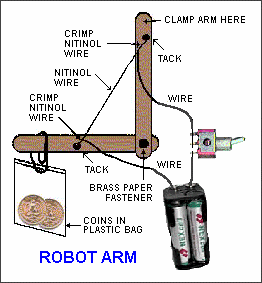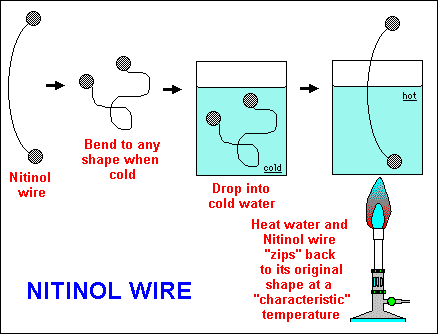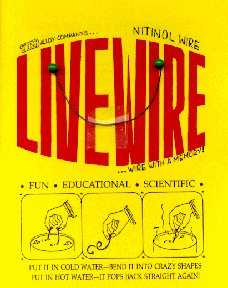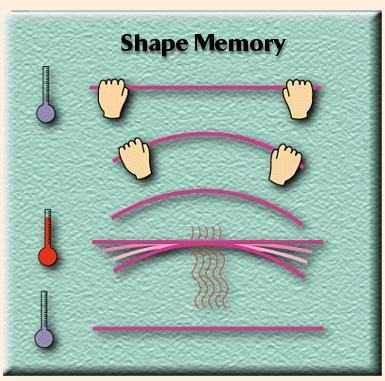Table Of Contents
Also called “Muscle Wire”
Nitinol SHORTENS in length when current flows through it:

Click the switch (and hold it down) to observe Nitinol wire in action
Latest News:
I have received an email from Jeff Brown of Dynalloy, (one of the manufacturers of Nitinol and Flexinol).
He asks me to point out that Flexinol is used in actuators.
Nitinol is not suitable for actuators.
Nitinol and Flexinol are also available as rod, tube, sheet as well as many other shapes and you should read the information on the company-website before making any decisions.
The number of applications for this type of product are enormous.
Here are some interesting links:
About Flexinol
About Nitinol
Links

Nitinol is a SHAPE MEMORY ALLOY made of nickel and titanium that SHORTENS in length when current flows through it. Nitinol changes shape when heated but returns to its original shape when cooled. Nitinol requires a “retuning force” to return it to its original length after current has been turned off. It does not return to its original length by itself.
BUILD A ROBOT ARM
A demonstration robot arm can be made with a short length of Nitinol and a few extra components as shown in the animation above. Nitinol is called Flexinol and possibly vise versa by the layman, but the two are not the same in performance. This website describes the two materials as equal but you should go to Dynalloy website to see the differences.
The components you will need are:
- 15cm (6”) Nitinol (150 micron - 0.006”) wire (also called muscle wire or memory wire)
- 2 Nitinol wire connectors
- 20-22 gauge stranded hook-up wire
- small plastic sandwich bag
- 2 AA batteries
- 1 battery holder
- 1 switch
- 2 tacks
- 1 brass paper fastener
- paper clip
- 10-20 coins
PROCEDURE
- Drill a hole in one end of each craft stick. Place the arms of the paper fastener through the two holes and bend them back to make the elbow joint, which should move easily.
- Bend each end of the Nitinol / Flexinol wire to form a loop and attach connectors by crimping to hold the wire in place. Make sure the connectors are tight enough to hold the wire loop in place. The loops will serve as attachment to the craft sticks.
- Use tacks to attach the loops to the sticks. The Nitinol should be long enough to hold the sticks at a right angle when the wire is taut.
- Secure the upper part of the arm by clamping it to a structure so that it hangs perpendicular to the ground. Put enough coins a plastic bag to keep the wire taut and hang the bag from the arm.
- Connect the positive lead from the battery holder to the connector at one end of the Nitinol wire and the negative lead to the other end, via a switch.
- Switch the circuit on. Observe what happens when current passes through the Flexinol / Nitinol wire. Switch off and allow the wire to recover. Add coins to the plastic bag to see how much mass your robotic arm can lift.
Specifications for this simple lever arm
- Voltage: 3 Volts
- Current: 375 milliamps
- Resistance: 8 ohms
- Power: 1125 milliwatts
- Wire Length: 15 cm (relaxed), 14 cm (contracted)
- Wire Force: 3.3 Newtons (330gm)
Sources of Flexinol / Nitinol:
The following suppliers have their own kit(s) as well as wire by the foot. You need to observe the minimum order value with some companies and the cost of postage:
Dynalloy Inc. http://www.dynalloy.com/
Sample Kit:
- 1 - 3” sample of .003” diameter low temp FLEXINOL™ actuator wire
- 1 - 3” sample of .005” diameter low temp FLEXINOL™ actuator wire
- 1 - 3” sample of .006” diameter low temp FLEXINOL™ actuator wire
- 1 - 3” sample of .006” diameter high temp FLEXINOL™ actuator wire
- 1 - Baseboard for mounting these projects on
- 10 - Push pins for mounting to the baseboard
- 10 - Small tubes for securing the push pins and covering their sharp ends
- 3 - Small springs
- 1 - 3 Volt Battery pack (with one alligator clip)
- 2 - Small lever arms
- 1 - Holding bracket for connecting the levers in project 3
You will also need 2 AA batteries
Sample Kit $29.95 plus $4.50 postage
SHAPE MEMORY APPLICATIONS inc http://www.sma-inc.com/
Nitinol Engineering Kit:
Intended for design and development engineers and students.
The Nitinol Engineering Kit contains “Using Shape Memory Alloys” (a simple design guide), 1 to 2 ft. of actuator wire, three demo wires, 1 foot of super-elastic wire, 1 tension spring, and 1 compression spring. Cost: $49.95 plus tax and shipping
Mondo-tronics Inc. http://www.mondo.com/ (other kits available too)
MW Super Sample Kit view kit
A quick and economical way to try a wide range Muscle Wires sizes. The Super Sample Kit includes 20 centimetres each of five diameters (037, 050, 100, 150, 250) in both low temp (LT) and high temp (HT) formulations. That’s ten separate Muscle Wires, two meters total, and includes crimps and technical specifications for all the wires. Cost: $29.95 plus $4.95 postage. (plus CA tax)
SW Wire & Wingbases view kit
A minimal kit for making your own Space Wings-like creations, or for repairing or upgrading old Space Wings. With two wingbase strips, and 14 cm of Flexinol 100 HT Muscle Wire - enough for two complete Space Wings. Cost: $10.00 plus $4.95 postage. (plus CA tax)
Space Wings Kit view kit
Now Variable Speed!
Sleek silvery mylar wings flap silently using only five centimetres of Muscle Wire. Perches on you computer, annoys cats, amuses babies.
Space Wings stands 15 centimetres tall and flaps up to 36 times per minute. Includes a printed circuit board, parts, & detailed instructions. Assembly requires soldering iron, solder, screw driver, wire cutters and two “AA” batteries. For ages 14 and up. A great first electronics kit & excellent hands-on introduction to electronic construction & Muscle Wires. Cost: $19.95 plus $4.95 postage.
Electric Piston Demo Kit view kit
Includes one piston, one high capacity Polapulse battery, two connecting leads, and complete instructions with plans for four complete projects. Cost: $19.95 plus $4.95 postage. (plus CA tax)
IMAGES SI Inc http://www.imagesco.com/catalog/nitinol/index.html (other kits available too)
Nitinol Rolling Ball Demo
This very simple device rolls a small ball back and forth inside a clear straw. It was made to demonstrate how Nitinol actuator wires continue working over a fixed range of motion for years. It operates about 20,000 cycles per day. It also happens to be a good way to introduce the theory of actuator wires. Cost: $24.95 plus $8.50 postage
Nitinol Air Valve
This is a fully functional electric valve made with Nitinol. It permits proportional control of the air or fluid flow. When voltage is applied the Nitinol inside contracts, opening the valve.
Cost: $17.95 plus $8.50 postage
Nitinol Butterfly
Another Nitinol demonstration of long life and durability, its beautiful lifelike motion makes it a great gift as well. It may be used with flowers in a lifelike setting or as a stand alone somewhere, perhaps a computer top. Cost: $34.95 plus $8.50 postage
Nitinol Wire (plus $8.50 postage)
| Diameter (inches) | Cost per foot: |
|---|---|
| 0.006 | $5.00 |
| 0.008 | $5.00 |
| 0.010 | $5.00 |
| 0.012 | $7.50 |
| 0.015 | $12.50 |
Monarch Butterfly Stock Number: CR30825-34 Edmund Scientific
A unique way to draw attention to your display. Elegant Aliforms™ are lifelike noiseless, motorless animated butterflies. The lifelike open-and-close motion is created by use of memory wire called Flexinol™. Simply plug in the 6V adapter (included) and the heat of the electricity contracts the Actuator Wire like a muscle. The Actuator Wire then relaxes when it cools. Aliforms™ can be attached to flower displays, plants, or anything else, to draw attention. Comes in Monarch version only. Note: the 6v adapter is INCLUDED! Cost: $29.95 plus $7.75 post
Monarch Butterfly also called: Nitinol Butterflies (4 different types)
These authentic-looking butterflies really flap their wings! The wings move once every two seconds, just like a resting butterfly. Just attach these butterflies to plants, picture frames, or your computer monitor. The wings move thanks to nitinol, the muscle of Stiquito. Comes with a 115v transformer and long cable.
Cost: $33.00 incl post (Pay by PayPal)
Experinmental Flexinol (Nitinol)
30 cm long (1ft) Flexinol is great for experiments.
ST-004 is 0.004” diameter.
ST-005 is 0.005” diameter. Prices include shipping: (Pay by PayPal) (International orders 50¢ extra!!)
Nitinol/Flexinol Wire (includes postage!!)
| Diameter (inches) | Cost per foot: |
|---|---|
| 0.004 | $3.00 |
| 0.005 | $3.00 |
The two sizes are also available by the metre for $10.00 per metre (incl post).
(Pay by PayPal)

Stiquito project Comes with book $33 (posted) (Pay by PayPal)
Click HERE for a review with pictures.
Read the first chapter of “Advanced Experiments with a Simple and Inexpensive Robot” by James M. Conrad and Jonathan W. Mills. Chapter 2 has detailed assembly instructions for constructing the Stiquito robot, so it looks like this is the best book to get. It comes with a Stiquito kit. Cost is $48.00 plus postage (for book and kit). Standard post is $8.00 If you are a member of IEEE Computer Society, the cost is $36.00 Click HERE to order.
To understand more about Stiquito and the books on Muscle wires, click HERE. (very good info)
THIRD STIQUITO BOOK
See details of the third book in the series: “Stiquito Controlled.” It is written by James Conrad, and his website is: (http://www.stiquito.com). The book comes with all components to build the robot and is based on a Texas Instruments MSP430F1122 processor. The board will make the robot walk and comes with instructions to reprogram the board, to do other things. You can use the board for almost any application. The board is 3.3” by 0.75”, and has a small prototyping area on it.
For an example of a similar model (NITLEMITE) you can build yourself from Lego blocks, click HERE.
World list of robotics info.
Crimped Flexinol (nitinol) (ST-006). 4-inch long Flexinol (0.004” diameter) and is crimped onto 4” of wire wrap wire at both ends. Cost: $4.50 including post (International orders 50¢ extra!!)
FEATURES:

Nitinol straightens out when heated. It can also be “trained” by shaping it within a flame to produce a new shape such as a square. It can then be bent to another shape when it is cold. It will return to a square when placed in hot water.

LiveWire can be purchased for approx us$4.00 plus $8.50 postage
Livewire is a fun little toy. According to the directions, you place it in cold water, bend the wire into any shape you want, then place it in hot water and the wire pops back into shape.
Livewire toy is made of nitinol wire with a low transition temperature (the temperature of hot water). When placed in hot water the wire will unfold and unbend itself (if bent out of shape), reverting back to its original shape. Nitinol fun products can be purchased HERE.

Shape Memory Alloys have a memory that returns after heating
PROPERTIES OF NITINOL by John Iovine
When Nitinol actuator wire is used as in the guidelines below, it can be expected to last tens of millions of cycles. If it is stressed or overheated due to a higher current, good motion may only be obtained for a few thousand or few hundred cycles, depending upon the severity of the stresses. Care should be taken to adhere to the following current limitations:
| Dia (micron) µ | Dia (in) | Dia (mm) | Resistance (Ohms/inch) | Maximum Pull Force (gms.) | Approx Current at Room Temp (mA) | Contraction Time (sec) | Off Time 70ºC (sec) |
|---|---|---|---|---|---|---|---|
| 37µ | 0.0015 | 0.037 | 21.0 | 17 | 30 | 1 | 1 |
| 50µ | 0.002 | 0.05 | 12.0 | 35 | 50 | 1 | 1 |
| 100µ | 0.004 | 0.1 | 3.0 | 150 | 180 | 1 | 1 |
| 125µ | 0.005 | 0.125 | 1 | 1 | |||
| 150µ | 0.006 | 0.15 | 1.3 | 330 | 400 | 1 | 2.0 |
| 200µ | 0.008 | 0.2 | 0.8 | 590 | 610 | 1 | 3.5 |
| 250µ | 0.010 | 0.25 | 0.5 | 930 | 1000 | 1 | 5.5 |
| 300µ | 0.012 | 0.3 | 0.33 | 1250 | 1750 | 1 | 8.0 |
| 375µ | 0.015 | 0.375 | 0.2 | 2000 | 2750 | 1 | 13.0 |
Note: One micron = one micrometre. 1 micron = 1/1,000,000metre 1 micron = 1µ 1,000,000µ = 1metre = 1m 1,000 micron = 1mm (millimetre) 1m = 100cm (centimetres) 10mm = 1cm 1,000mm = 1m 100µ = 0.1mm etc
Contraction time is directly related to current delivered. The guidelines above are only approximate, as other factors such as ambient temperature, air currents and heat-sinking will alter the value.
Flexinol Wire Properties:
| Wire Diameter (µm) | Linear Resistance (ohm/m) | Typical Current (mA) | Relaxation Force (grams) | Contraction Force (grams) | Repetition Rate** (LT/HT) |
|---|---|---|---|---|---|
| 37µ | 860 | 30 | 4 | 20 | 52/68 |
| 50µ | 510 | 50 | 8 | 35 | 46/67 |
| 100µ | 150 | 180 | 28 | 150 | 33/50 |
| 150µ | 50 | 400 | 62 | 330 | 20/30 |
| 250µ | 20 | 1,000 | 172 | 930 | 9/13 |
| 300µ | 13 | 1,750 | 245 | 1,250 | 7/9 |
| 375µ | 8 | 2,750 | 393 | 2,000 | 4/5 |
** Cycles per minute, in still air, at 20°C
LT = low temp 70°C, HT high temp 90°C
Tags
Quick Links
Legal Stuff
Social Media


